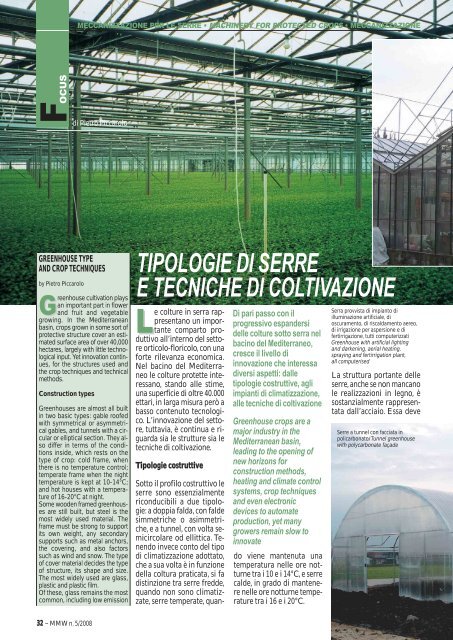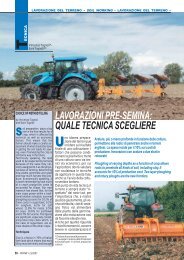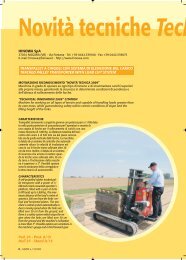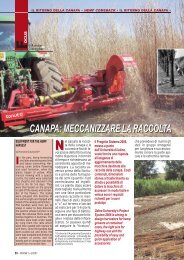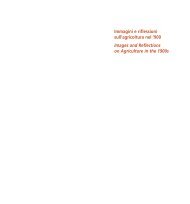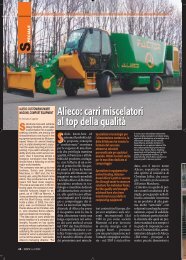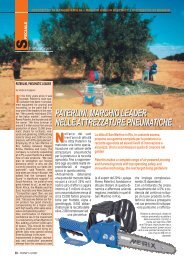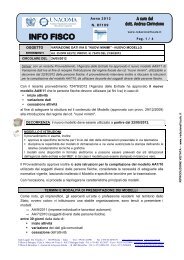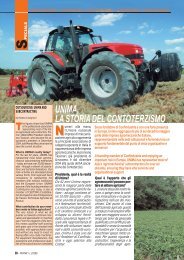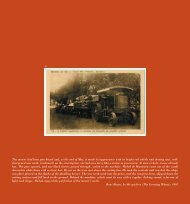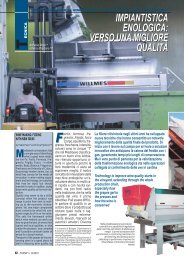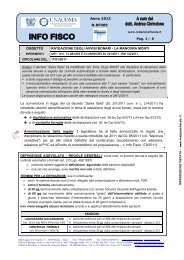tipologie di serre e tecniche di coltivazione - FederUnacoma
tipologie di serre e tecniche di coltivazione - FederUnacoma
tipologie di serre e tecniche di coltivazione - FederUnacoma
Create successful ePaper yourself
Turn your PDF publications into a flip-book with our unique Google optimized e-Paper software.
OCUS<br />
F<br />
32 – MMW n. 5/2008<br />
MECCANIZZAZIONE PER LE SERRE • MACHINERY FOR PROTECTED CROPS • MECCANIZZAZIONE<br />
<strong>di</strong> Pietro Piccarolo<br />
GREENHOUSE TYPE<br />
AND CROP TECHNIQUES<br />
by Pietro Piccarolo<br />
G reenhouse<br />
cultivation plays<br />
an important part in flower<br />
and fruit and vegetable<br />
growing. In the Me<strong>di</strong>terranean<br />
basin, crops grown in some sort of<br />
protective structure cover an estimated<br />
surface area of over 40,000<br />
hectares, largely with little technological<br />
input. Yet innovation continues,<br />
for the structures used and<br />
the crop techniques and technical<br />
methods.<br />
Construction types<br />
Greenhouses are almost all built<br />
in two basic types: gable roofed<br />
with symmetrical or asymmetrical<br />
gables, and tunnels with a circular<br />
or elliptical section. They also<br />
<strong>di</strong>ffer in terms of the con<strong>di</strong>tions<br />
inside, which rests on the<br />
type of crop: cold frame, when<br />
there is no temperature control;<br />
temperate frame when the night<br />
temperature is kept at 10-14°C;<br />
and hot houses with a temperature<br />
of 16-20°C at night.<br />
Some wooden framed greenhouses<br />
are still built, but steel is the<br />
most widely used material. The<br />
frame must be strong to support<br />
its own weight, any secondary<br />
supports such as metal anchors,<br />
the covering, and also factors<br />
such as wind and snow. The type<br />
of cover material decides the type<br />
of structure, its shape and size.<br />
The most widely used are glass,<br />
plastic and plastic film.<br />
Of these, glass remains the most<br />
common, inclu<strong>di</strong>ng low emission<br />
TIPOLOGIE DI SERRE<br />
E TECNICHE DI COLTIVAZIONE<br />
Le colture in serra rappresentano<br />
un importante<br />
comparto produttivo<br />
all’interno del settore<br />
orticolo-floricolo, con una<br />
forte rilevanza economica.<br />
Nel bacino del Me<strong>di</strong>terraneo<br />
le colture protette interessano,<br />
stando alle stime,<br />
una superficie <strong>di</strong> oltre 40.000<br />
ettari, in larga misura però a<br />
basso contenuto tecnologico.<br />
L’innovazione del settore,<br />
tuttavia, è continua e riguarda<br />
sia le strutture sia le<br />
<strong>tecniche</strong> <strong>di</strong> <strong>coltivazione</strong>.<br />
Tipologie costruttive<br />
Sotto il profilo costruttivo le<br />
<strong>serre</strong> sono essenzialmente<br />
riconducibili a due <strong>tipologie</strong>:<br />
a doppia falda, con falde<br />
simmetriche o asimmetriche,<br />
e a tunnel, con volta semicircolare<br />
od ellittica. Tenendo<br />
invece conto del tipo<br />
<strong>di</strong> climatizzazione adottato,<br />
che a sua volta è in funzione<br />
della coltura praticata, si fa<br />
<strong>di</strong>stinzione tra <strong>serre</strong> fredde,<br />
quando non sono climatizzate,<br />
<strong>serre</strong> temperate, quan-<br />
Di pari passo con il<br />
progressivo espandersi<br />
delle colture sotto serra nel<br />
bacino del Me<strong>di</strong>terraneo,<br />
cresce il livello <strong>di</strong><br />
innovazione che interessa<br />
<strong>di</strong>versi aspetti: dalle<br />
<strong>tipologie</strong> costruttive, agli<br />
impianti <strong>di</strong> climatizzazione,<br />
alle <strong>tecniche</strong> <strong>di</strong> <strong>coltivazione</strong><br />
Greenhouse crops are a<br />
major industry in the<br />
Me<strong>di</strong>terranean basin,<br />
lea<strong>di</strong>ng to the opening of<br />
new horizons for<br />
construction methods,<br />
heating and climate control<br />
systems, crop techniques<br />
and even electronic<br />
devices to automate<br />
production, yet many<br />
growers remain slow to<br />
innovate<br />
do viene mantenuta una<br />
temperatura nelle ore notturne<br />
tra i 10 e i 14°C, e <strong>serre</strong><br />
calde, in grado <strong>di</strong> mantenere<br />
nelle ore notturne temperature<br />
tra i 16 e i 20°C.<br />
Serra provvista <strong>di</strong> impianto <strong>di</strong><br />
illuminazione artificiale, <strong>di</strong><br />
oscuramento, <strong>di</strong> riscaldamento aereo,<br />
<strong>di</strong> irrigazione per aspersione e <strong>di</strong><br />
fertirrigazione, tutti computerizzati<br />
Greenhouse with artificial lighting<br />
and darkening, aerial heating,<br />
spraying and fertirrigation plant,<br />
all computerised<br />
La struttura portante delle<br />
<strong>serre</strong>, anche se non mancano<br />
le realizzazioni in legno, è<br />
sostanzialmente rappresentata<br />
dall’acciaio. Essa deve<br />
Serre a tunnel con facciata in<br />
policarbonato/Tunnel greenhouse<br />
with polycarbonate façade
MECCANIZZAZIONE PER LE SERRE • MACHINERY FOR PROTECTED CROPS • MECCANIZZAZIONE PER LE SERRE<br />
essere in grado <strong>di</strong> sopportare<br />
non solo il proprio peso, insieme<br />
a quello della struttura<br />
secondaria (supporti metallici<br />
<strong>di</strong> ancoraggio) e della<br />
copertura, ma anche i carichi<br />
accidentali come quelli<br />
del vento e della neve. I materiali<br />
<strong>di</strong> copertura con<strong>di</strong>zionano<br />
il tipo <strong>di</strong> struttura, la<br />
forma e le <strong>di</strong>mensioni e sono<br />
sostanzialmente riconducibili<br />
al vetro, alla plastica e<br />
ai film plastici. Il vetro è tuttora<br />
il materiale più impiegato.Accanto<br />
al vetro comu-<br />
ne è utilizzato anche quello<br />
a bassa emissività, ottenuto<br />
trattando superficialmente<br />
una delle due facce della lastra<br />
con ossi<strong>di</strong> metallici, in<br />
modo da ridurre le <strong>di</strong>spersioni<br />
termiche per irraggiamento.<br />
Molto utilizzati sono<br />
anche i materiali plastici rigi<strong>di</strong>,<br />
quali il policarbonato,<br />
le resine poliesteri rinforzate<br />
e il policloruro <strong>di</strong> vinile<br />
(pvc). In particolare il policarbonato<br />
ha avuto una notevole<br />
<strong>di</strong>ffusione nelle coperture<br />
delle <strong>serre</strong>, sia a tun-<br />
nel sia a doppia falda, mentre<br />
la resina poliestere interessa<br />
essenzialmente le <strong>serre</strong><br />
a tunnel. I film plastici sono<br />
utilizzati nei tunnel specie<br />
in orticoltura e per le<br />
piante ornamentali a minore<br />
esigenza termica. I materiali<br />
più <strong>di</strong>ffusi sono il polietilene<br />
e il pvc, prodotti in vari<br />
spessori. Generalmente la<br />
durata non va oltre i do<strong>di</strong>ci<br />
mesi.<br />
Climatizzazione<br />
Climatizzare una serra significa<br />
effettuare il controllo<br />
non solo della temperatura<br />
ma anche dell’umi<strong>di</strong>tà relativa,<br />
della luminosità ambientale<br />
e del ricambio dell’aria.<br />
Nelle <strong>serre</strong> temperate<br />
e calde il riscaldamento è la<br />
componente più importante.<br />
Non essendo sufficiente<br />
l’“effetto serra” per garantire<br />
la temperatura, il riscaldamento<br />
artificiale è quasi<br />
sempre in<strong>di</strong>spensabile. Esso<br />
si ottiene generalmente con<br />
aerotermi, cioè generatori<br />
d’aria calda dotati <strong>di</strong> ventilatori.<br />
La tipologia più <strong>di</strong>ffusa<br />
per il riscaldamento dell’aria<br />
è quella sospesa che<br />
insuffla aria calda in una tu-<br />
Serre a doppia falda in vetro<br />
Gabled glasshouse<br />
types of glass with which one<br />
side is treated with metal oxides<br />
to reduce heat loss. Also very<br />
common are rigid plastics such as<br />
polycarbonate, reinforced polyester<br />
resins and polyvinyl chloride<br />
(PVC). Polycarbonate in particular<br />
has come to be widely used in<br />
both tunnel and gabled greenhouses,<br />
whereas polyester resins<br />
are found mostly in tunnel structures.<br />
Plastic film is used in tunnels,<br />
especially for market-garden<br />
crops and ornamental plants having<br />
lower heat requirements. The<br />
most widely used films are polyethylene<br />
and PVC produced in<br />
various thicknesses. Generally,<br />
they last no longer than twelve<br />
months.<br />
Climatisation<br />
Controlled greenhouse con<strong>di</strong>tions<br />
means controlling not only<br />
the temperature, but also humi<strong>di</strong>ty,<br />
illumination and air flows.<br />
In hot and temperate greenhouses,<br />
heating is the most important<br />
component. The ‘greenhouse effect’<br />
is not enough to guarantee<br />
the temperature, so artificial<br />
heating is almost always in<strong>di</strong>spensable.<br />
It is generally produced<br />
by hot air generators fitted<br />
with fans. The most common<br />
type is suspended in the air and<br />
blows the hot air through a suspended<br />
pipe made of plastic film<br />
with holes in it. Heating can also<br />
be applied to the substrate in<br />
which the plants grow, using<br />
PVC pipes buried or laid on the<br />
bottom of the growing bench.<br />
When the plants are planted in<br />
the ground, the pipes can be<br />
buried down to 20-30 cm.<br />
In the summer, the ‘greenhouse<br />
effect’ creates overheating so the<br />
greenhouse will need cooling by<br />
sha<strong>di</strong>ng it and ensuring that it is<br />
ventilated, naturally or artificially.<br />
There are also cooling or fog systems<br />
which exploit water evaporation<br />
to freshen the atmosphere<br />
without sha<strong>di</strong>ng. A cooling system<br />
has ventilators down one<br />
wall and a battery of honeycomb<br />
humi<strong>di</strong>fying panels opposite. The<br />
ventilators have to have a high<br />
capacity since they have to ensure<br />
frequent circulation of the<br />
air. They are chosen and positioned<br />
to suck low-velocity air<br />
from the panels. About 2 litres of<br />
MMW n. 5/2008 – 33
MECCANIZZAZIONE PER LE SERRE • MACHINERY FOR PROTECTED CROPS • MECCANIZZAZIONE PER LE SERRE<br />
water per m 2 is enough to dose<br />
the panels. The fog system requires<br />
the spraying of high-pressure<br />
water spray (at 35-40 bar)<br />
inside the greenhouse from nozzles<br />
mounted on pipes above the<br />
crops.<br />
The whole operation of a modern<br />
greenhouse – sha<strong>di</strong>ng tarps,<br />
mechanised opening and closing,<br />
heat regulation, etc. – can be<br />
managed fully from a computer<br />
on the basis of information from<br />
sensors and peripheral microprocessors.<br />
Heat accumulation in the ground<br />
Soil temperatures remain more<br />
constant than air temperatures<br />
and are less influenced by external<br />
weather con<strong>di</strong>tions the deeper<br />
you go. This is the basis for<br />
greenhouse designs in which the<br />
temperature is stabilised by forcing<br />
the air circulate through corrugated<br />
pipes sunk into the soil.<br />
In the summer, the air from outside<br />
entering the pipes where<br />
the fan is, is hotter than the<br />
ground. As it moves through the<br />
pipes, it passes heat to the<br />
ground and emerges cooler so<br />
that it can cool the greenhouse.<br />
At the same time, the ground<br />
warms up.<br />
The technique also has an interesting<br />
potential for cold seasons.<br />
The air circulating through the<br />
greenhouse picks up heat accumulated<br />
by the soil during the<br />
day and returns the heat during<br />
the night, keeping the temperature<br />
in the greenhouse higher<br />
during the night. The system can<br />
be improved with heat accumulation<br />
devices, for example, water<br />
tanks sunk in the soil and traversed<br />
by the air pipes.<br />
34 – MMW n. 5/2008<br />
bazione in film plastico forato,<br />
anch’essa sospesa.<br />
Per il riscaldamento del substrato<br />
<strong>di</strong> <strong>coltivazione</strong> si impiegano<br />
invece tubazioni in<br />
pvc posizionate all’interno<br />
dello stesso o sul fondo del<br />
bancale. Nella <strong>coltivazione</strong><br />
a terra le tubazioni vanno<br />
interrate ad una profon<strong>di</strong>tà<br />
<strong>di</strong> 20-30 cm.<br />
Nel periodo estivo l’“effetto<br />
serra” crea problemi <strong>di</strong> surriscaldamento<br />
per cui occorre<br />
raffrescare la serra ricorrendo<br />
all’effetto combinato<br />
<strong>di</strong> ombreggiamento e ventilazione<br />
naturale o forzata.Vi<br />
sono poi sistemi che sfruttano<br />
l’evaporazione dell’acqua<br />
per produrre il raffrescamento<br />
e che non richiedono<br />
l’ombreggiamento. Si tratta<br />
dei cosiddetti “cooling system”e<br />
“fog system”. Il “cooling<br />
system” è costituito da<br />
ventilatori sistemati su una<br />
parete e da una batteria <strong>di</strong><br />
pannelli alveolati umi<strong>di</strong>ficatori<br />
collocati nella parete opposta.<br />
I ventilatori, dovendo<br />
garantire un frequente ricambio<br />
dell’aria, hanno elevate<br />
portate e sono scelti e<br />
posizionati in modo da aspirare<br />
dai pannelli umi<strong>di</strong>ficatori<br />
aria a bassa velocità. La<br />
quantità d’acqua da dosare<br />
sui panelli è intorno a 2 litri<br />
per m 2 <strong>di</strong> pannello.<br />
Il “fog system” consiste nella<br />
<strong>di</strong>ffusione in serra <strong>di</strong> acqua<br />
Coltivazioni in vaso su bancali<br />
Vases on growing bench<br />
Serre con telo <strong>di</strong> ombreggiamento<br />
Greenhouse with sha<strong>di</strong>ng tarp<br />
nebulizzata ad alta pressione<br />
(35-40 bar) ad opera <strong>di</strong><br />
ugelli montati su tubazioni<br />
poste sopra la coltura. L’intero<br />
sistema operativo delle<br />
<strong>serre</strong> moderne (teli-ombreggianti,<br />
aperture e chiusure<br />
meccanizzate, regolazione<br />
termica, ecc.) può essere gestito<br />
interamente da computer<br />
sulla base degli input trasmessi<br />
da sensori e da microprocessori<br />
periferici.<br />
L’accumulo termico<br />
nel terreno<br />
Com’è noto, le temperature<br />
nel suolo sono più costanti<br />
rispetto a quelle dell’aria e<br />
meno influenzabili dalle variazioni<br />
climatiche esterne a
MECCANIZZAZIONE PER LE SERRE • MACHINERY FOR PROTECTED CROPS • MECCANIZZAZIONE PER LE SERRE<br />
Bancali fissi in calcestruzzo<br />
Fixed concrete benches<br />
mano a mano che la profon<strong>di</strong>tà<br />
aumenta. Queste considerazioni<br />
hanno suggerito la<br />
messa a punto <strong>di</strong> sistemi<br />
adatti alla stabilizzazione<br />
della temperatura nelle <strong>serre</strong><br />
che si basano sulla circolazione<br />
forzata dell’aria all’interno<br />
<strong>di</strong> tubi corrugati sistemati<br />
nel terreno. Nel periodo<br />
estivo l’aria esterna che<br />
entra nei tubi in corrispondenza<br />
del ventilatore è più<br />
calda del terreno. Nel passaggio<br />
all’interno dei tubi<br />
sotterranei essa cede il proprio<br />
calore al terreno ed esce<br />
più fresca e può raffreddare<br />
la serra. Nello stesso tempo<br />
il terreno si scalda. Questa<br />
tecnica ha un’interessante<br />
possibilità <strong>di</strong> applicazione<br />
nelle <strong>serre</strong> in stagione fredda.<br />
Il sistema prevede <strong>di</strong> far<br />
ricircolare l’aria della serra,<br />
con l’accumulo del calore<br />
nel terreno durante il giorno<br />
e la restituzione del calore<br />
durante la notte, con il risultato<br />
<strong>di</strong> mantenere più alta la<br />
temperatura della serra durante<br />
le ore notturne. Il sistema<br />
può essere migliorato<br />
prevedendo sistemi <strong>di</strong> accu-<br />
mulo costituiti, ad esempio,<br />
da serbatoi con un certo volume<br />
d’acqua posti nel suolo<br />
e attraversati dalle tubazioni<br />
dell’aria.<br />
Tecniche <strong>di</strong> <strong>coltivazione</strong><br />
In funzione della tecnica <strong>di</strong><br />
<strong>coltivazione</strong> occorre <strong>di</strong>stinguere<br />
tra <strong>serre</strong> con <strong>coltivazione</strong><br />
su suolo e <strong>serre</strong> con<br />
<strong>coltivazione</strong> fuori suolo.<br />
Crop techniques<br />
Varying techniques can be used<br />
to grow greenhouse crops, the<br />
biggest <strong>di</strong>fference being between<br />
those that use soil and those that<br />
don’t.<br />
If soil is used, the plants can grow<br />
in the ground or in containers on<br />
growing benches, which are fixed<br />
or mobile and normally use natural<br />
or artificial growing me<strong>di</strong>ums<br />
above all for ornamental plants.<br />
Fixed benches can be constructed<br />
out of metal or concrete prefabricated<br />
units. The benches are<br />
about 1.6-2 meters wide, but they<br />
need walkways between them so<br />
it is unlikely to use more than 75%<br />
of the total surface area. Mobile<br />
MMW n. 5/2008 – 35
MECCANIZZAZIONE PER LE SERRE • MACHINERY FOR PROTECTED CROPS • MECCANIZZAZIONE PER LE SERRE<br />
benches are usually made of aluminium<br />
for lightness and resistance<br />
to corrosion. They are about<br />
the same size as fixed benches,<br />
but can be moved on wheels or<br />
rollers, which also leaves passage<br />
ways free. This means more of the<br />
total surface can be used. There<br />
are also suspended benches,<br />
which may increase the usable<br />
surface to over 100% of the basic<br />
area under glass.<br />
When cultivation is in the ground,<br />
the covered area is split up into<br />
beds with cement slabs 20-30<br />
cm high. The beds are about a<br />
meter wide, and there is a passage<br />
way between them. The<br />
growing area can be isolated<br />
from the rest of the soil by inserting<br />
a plastic film at the appropriate<br />
depth, but drainage must be<br />
ensured.<br />
Growing without soil uses an inert<br />
and porous material such as<br />
perlite, vermiculite, expanded<br />
clay, coconut fibre, pumice stone<br />
and so on through which a nutrient<br />
solution can be passed. The<br />
nutrient can be used in a closed<br />
or an open circuit system accor<strong>di</strong>ng<br />
to whether the nutrient is to<br />
be recovered. No-soil crops are a<br />
big novelty of recent years, although<br />
few Italian growers use it.<br />
In Italy, it accounts for around 3%<br />
of the area grown with protected<br />
crops, in Holland over 50%.<br />
The technique offers advantages<br />
in managing the mineral nutrition<br />
made available to the plants, and<br />
this can also be controlled by<br />
special software which determines<br />
how much of each mineral<br />
salt to <strong>di</strong>ssolve. Disease control is<br />
also easier. Their failure hitherto<br />
to find widespread support in Italy<br />
stems from a lack of technical<br />
and professional training and the<br />
higher initial investment needed.<br />
Apart from the chemical composition,<br />
the nutrient parameters to<br />
be kept under control are the pH,<br />
to be kept within an established<br />
range to ensure solubility of the<br />
nutrient elements and exchange<br />
between the roots and the nutri-<br />
36 – MMW n. 5/2008<br />
CCoollttiivvaazziioonnee ssuu ssuuoolloo<br />
Le coltivazioni su suolo in<br />
ambiente protetto possono<br />
essere a terra o su bancali. I<br />
bancali sono normalmente<br />
realizzati per le piante ornamentali<br />
e la <strong>coltivazione</strong> è<br />
fatta su substrati naturali o<br />
artificiali. Possono essere fissi<br />
o mobili. Quelli fissi sono<br />
generalmente realizzati con<br />
strutture prefabbricate in<br />
metallo o calcestruzzo ed<br />
hanno larghezza <strong>di</strong> 1,6-2 m.<br />
La superficie utilizzata, stante<br />
l’esigenza <strong>di</strong> lasciare libe-<br />
Riscaldamento con tubazioni in pvc<br />
posizionate sul fondo del bancale<br />
PVC heating pipes installed on bench<br />
Bancali <strong>di</strong> ra<strong>di</strong>cazione fissi in alluminio<br />
Fixed aluminium rooting benches<br />
re le corsie <strong>di</strong> passaggio, <strong>di</strong>fficilmente<br />
supera il 75 % <strong>di</strong><br />
quella coperta.<br />
I bancali mobili, per esigenza<br />
<strong>di</strong> leggerezza e resistenza<br />
alla corrosione, vengono<br />
generalmente realizzati in<br />
alluminio. Hanno le stesse<br />
<strong>di</strong>mensioni dei bancali fissi<br />
ma, essendo spostabili su<br />
rulli, la corsia <strong>di</strong> passaggio<br />
non è fissa ma viene creata<br />
<strong>di</strong> volta in volta: aumenta<br />
così la superficie utilizzabile.<br />
Si impiegano anche bancali<br />
sospesi; soluzione che<br />
consente <strong>di</strong> avere una su-<br />
perficie utilizzata anche superiore<br />
al 100% <strong>di</strong> quella<br />
coperta.<br />
Nelle <strong>coltivazione</strong> a terra<br />
vengono realizzate anche le<br />
cosiddette “banquette”. Il<br />
terreno della serra viene <strong>di</strong>viso<br />
in aree delimitate da<br />
lastre <strong>di</strong> cemento alte 20–30<br />
cm in modo da creare “letti”<br />
<strong>di</strong> <strong>coltivazione</strong> <strong>di</strong> larghezza<br />
pari o superiore al<br />
metro. Tra un’area e l’altra<br />
si lasciano, come per i bancali<br />
fissi, corsie <strong>di</strong> passaggio.<br />
A <strong>di</strong>fferenza del bancale, il<br />
substrato <strong>di</strong> <strong>coltivazione</strong><br />
non è separato dal suolo.<br />
Un isolamento può essere
MECCANIZZAZIONE PER LE SERRE • MACHINERY FOR<br />
realizzato ponendo sul fondo<br />
un film <strong>di</strong> plastica e assicurando<br />
però il drenaggio<br />
delle acque <strong>di</strong> irrigazione.<br />
CCoollttiivvaazziioonnee ffuuoorrii ssuuoolloo<br />
Nelle <strong>serre</strong> con coltivazioni<br />
fuori suolo la forma più <strong>di</strong>ffusa<br />
si basa sull’utilizzo come<br />
substrato <strong>di</strong> un materiale<br />
inerte e poroso (perlite, vermiculite,<br />
argilla espansa, fibra<br />
<strong>di</strong> cocco, pomice, ecc.),<br />
su cui si fa passare una soluzione<br />
nutritiva preventivamente<br />
preparata. In funzione<br />
del recupero della soluzione<br />
nutritiva, si ha la <strong>di</strong>stinzione<br />
tra ciclo chiuso e<br />
ciclo aperto. Le colture fuori<br />
suolo rappresentano un’innovazione<br />
significativa introdotta<br />
nel settore delle<br />
colture protette in questi ultimi<br />
anni. Attualmente in<br />
Italia la tecnica è ancora<br />
poco <strong>di</strong>ffusa, interessando<br />
circa il 3% dell’intera superficie<br />
a colture protette,<br />
mentre in Paesi come l’Olanda<br />
l’incidenza percentuale<br />
supera il 50%.<br />
Malgrado il vantaggio che<br />
questa tecnica offre, specie<br />
nella gestione della nutrizione<br />
minerale (anche attraverso<br />
software all’uopo<br />
realizzati che aiutano a calcolare<br />
la quantità <strong>di</strong> sale so-<br />
lubile da sciogliere nell’acqua)<br />
ed anche nel maggior<br />
controllo delle malattie, le<br />
colture fuori suolo stentano<br />
a <strong>di</strong>ffondersi, sia per carenza<br />
<strong>di</strong> una adeguata preparazione<br />
tecnico-professionale<br />
sia per il maggior investimento<br />
iniziale che queste<br />
richiedono.<br />
Nella gestione della soluzione<br />
nutritiva, oltre alla composizione<br />
chimica della stessa,i<br />
parametri da tenere sotto<br />
controllo sono il pH, che deve<br />
essere mantenuto entro<br />
un range stabilito per non<br />
compromettere la solubilità<br />
degli elementi nutritivi e lo<br />
scambio tra l’apparato ra<strong>di</strong>cale<br />
e la soluzione stessa; la<br />
conducibilità elettrica (Ec),<br />
da cui <strong>di</strong>pende il controllo<br />
della concentrazione della<br />
soluzione nutritiva (una bassa<br />
conducibilità in<strong>di</strong>ca una<br />
<strong>di</strong>luizione eccessiva della soluzione,<br />
mentre un’alta conducibilità<br />
equivale ad una<br />
concentrazione elevata e ad<br />
una tensione osmotica eccessiva);<br />
il ciclo <strong>di</strong> erogazione e<br />
le portate, da cui deriva il<br />
controllo complessivo della<br />
nutrizione minerale attraverso<br />
il ricambio della soluzione.<br />
Il ricambio della soluzione richiede,evidentemente,un’attenta<br />
gestione specie per le
MECCANIZZAZIONE PER LE SERRE • MACHINERY FOR PROTECTED CROPS • MECCANIZZAZIONE PER LE SERRE<br />
colture fuori suolo a ciclo<br />
chiuso. Gestione che per essere<br />
accurata non può che<br />
essere informatizzata con<br />
software a ciò de<strong>di</strong>cati e basati<br />
su modelli <strong>di</strong> calcolo re-<br />
lativi: alla crescita della coltura,<br />
ai consumi idrici della<br />
concentrazione della soluzione,<br />
alla salinità all’interno<br />
del substrato. Su questi<br />
aspetti la ricerca è molto at-<br />
Sopra e a lato: serra riscaldata con<br />
generatori <strong>di</strong> aria calda/Above and on<br />
the left: heating units in greenhouse<br />
tiva, così come sull’influenza<br />
del tipo <strong>di</strong> substrato e <strong>di</strong><br />
contenitore dello stesso.<br />
Un sistema idroponico semplificato<br />
sviluppato agli inizi<br />
degli anni ’70 del secolo scorso<br />
in Inghilterra (coltura in<br />
“Nutrient Film Technique”,<br />
ent; electrical conductivity since<br />
low conductivity in<strong>di</strong>cates that<br />
the nutrient has been <strong>di</strong>luted excessively<br />
while high conductivity<br />
means high concentration and<br />
excessive osmotic tension; the<br />
application and flow rate cycle<br />
on which overall control of nutrition<br />
is exerted via the rotation of<br />
the nutrient solution.<br />
The solution’s rotation evidently<br />
requires careful management,<br />
especially with no-soil crops in a
MECCANIZZAZIONE PER LE SERRE • MACHINERY FOR PROTECTED CROPS • MECCANIZZAZIONE PER LE SERRE<br />
closed circuit system. The best<br />
way is to use software which is<br />
the most accurate form of control,<br />
by calculating crop growth,<br />
water consumption, the nutrient’s<br />
concentration and salinity in the<br />
growing me<strong>di</strong>um. These aspects<br />
are the topic of very active research,<br />
on for example the influence<br />
of the growing me<strong>di</strong>um and<br />
the container.<br />
A simplified hydroponic technique<br />
known as Nutrient Film<br />
Technique or NFT was developed<br />
in England in the 1970s. using<br />
small channels at a slope of 1-<br />
1.5% covered with an opaque<br />
plastic roof. The plants are started<br />
in inert materials such as perlite<br />
or rock wool and then placed<br />
over a channel containing a fine,<br />
continuous flow of nutrient. In<br />
this way, the roots are always<br />
bathed in a veil of nutrient solution<br />
continually on the move so<br />
there is no need for it to be aerated<br />
artificially. Of course, the nutrient<br />
is kept moving by a pump<br />
with continuous control of pH<br />
and heat conductivity.<br />
Artificial lighting<br />
During the northern European<br />
winter, the reduced amount of<br />
light each day is a big limit on<br />
plant growth, so artificial lighting<br />
is used, normally with an installed<br />
power of around 50 W per m 2 .<br />
Since a good part of the electricity<br />
is converted into heat, artificial<br />
lighting also contributes to heating.<br />
Fluorescent lights are normally<br />
used. Incandescent light is not<br />
advisable because of the electricity<br />
consumed and also the light<br />
emitted at the red end of the<br />
spectrum, which is no use for<br />
plant growth. In a Me<strong>di</strong>terranean<br />
country like Italy, the need for artificial<br />
light is less important, and<br />
artificial lighting is only used for<br />
particular purposes, for example,<br />
to force bulbs or flowers for which<br />
up to 100 W per m 2 may be used.<br />
Tagging in the greenhouse<br />
In Holland, Walking Plant Systems,<br />
one of the major suppliers<br />
of greenhouse management systems,<br />
uses electronic tagging<br />
employed in the automatic identification<br />
of people and things to<br />
keep track of each in<strong>di</strong>vidual vase<br />
40 – MMW n. 5/2008<br />
NTF) prevede l’impiego <strong>di</strong><br />
canalette aventi inclinazione<br />
dell’ 1-1,5% protette nella<br />
parte superiore da un tetto<br />
<strong>di</strong> plastica opaco. Le piantine<br />
precoltivate su materiali<br />
inerte (perlite, lana <strong>di</strong> roccia)<br />
sono appoggiate sulla canaletta<br />
entro cui scorre la soluzione<br />
nutritiva in strato sottile<br />
e continuo. In questo modo<br />
le ra<strong>di</strong>ci sono bagnate da<br />
un velo <strong>di</strong> soluzione sempre<br />
Coltivazione fuori suolo <strong>di</strong> meloni<br />
Cultivation of hydroponically-grown<br />
melons<br />
in movimento per cui viene<br />
meno la necessità <strong>di</strong> aerare<br />
artificialmente la soluzione.<br />
Naturalmente la messa in<br />
circolo della soluzione nutritiva<br />
viene fatta tramite pompa<br />
con il controllo continuo<br />
del pH e della conducibilità<br />
termica.<br />
Illuminazione artificiale<br />
Nel Nord Europa nel periodo<br />
invernale il ridotto numero<br />
<strong>di</strong> ore giornaliere <strong>di</strong><br />
illuminazione limita forte-<br />
Substrato <strong>di</strong> perlite per coltura fuori<br />
suolo/Perlite substrate for cultivations<br />
without soil<br />
mente le possibilità <strong>di</strong> crescita<br />
delle piante. Si ricorre<br />
così all’illuminazione artificiale.<br />
La potenza elettrica<br />
normalmente installata è<br />
dell’or<strong>di</strong>ne <strong>di</strong> 50 W/m 2 .Poiché<br />
buona parte dell’energia<br />
elettrica viene convertita<br />
in calore l’illuminazione<br />
artificiale contribuisce anche<br />
al riscaldamento. Vengono<br />
usate per lo più lampade<br />
fluorescenti mentre<br />
sono sconsigliate le lampade<br />
ad incandescenza sia per<br />
i consumi elevati sia per la<br />
fascia <strong>di</strong> luce rossa emessa<br />
inadatta alla crescita delle<br />
piante.<br />
In Italia il problema è meno<br />
sentito e il ricorso all’illuminazione<br />
artificiale viene fatto<br />
per scopi particolari. Ad<br />
esempio per la forzatura dei<br />
bulbi o delle piante da fiore,<br />
dove si arriva a potenze<br />
elettriche <strong>di</strong> 100 W/m 2 .<br />
Tecniche <strong>di</strong> coltivazioni con<br />
tecnologia Rfid<br />
In Olanda la Walking Plant<br />
System (WPS), uno dei principali<br />
fornitori olandesi <strong>di</strong><br />
sistemi <strong>di</strong> gestione per <strong>serre</strong>,<br />
avvalendosi della tecnologia<br />
fornita da <strong>di</strong>tte specializzate<br />
nell’identificazione<br />
automatica <strong>di</strong> merci e persone<br />
e nella realizzazione <strong>di</strong><br />
software, contrassegnando<br />
con un transponder (tag)<br />
ogni singolo vaso <strong>di</strong> fiori, è<br />
riuscita a ottimizzare l’intero<br />
processo <strong>di</strong> <strong>coltivazione</strong><br />
in serra.<br />
Con questo progetto la WPS<br />
ha <strong>di</strong>mostrato come l’impiego<br />
della tecnologia Rfid (Ra<strong>di</strong>o<br />
Frequency Identification)<br />
possa avere interessanti possibilità<br />
<strong>di</strong> utilizzazione anche<br />
nelle <strong>serre</strong>.Il sistema messo a
MECCANIZZAZIONE PER LE SERRE • MACHINERY FOR PROTECTED CROPS • MECCANIZZAZIONE PER LE SERRE<br />
punto integrando tra loro la<br />
tecnologia Rfid con quella<br />
delle immagini è completamente<br />
automatizzato lungo<br />
tutto il ciclo <strong>di</strong> vita della pianta,dalla<br />
semina alla ven<strong>di</strong>ta al<br />
cliente finale. Il software <strong>di</strong><br />
gestione fa sì che ogni pianta<br />
possa ricevere un trattamento<br />
specifico, in funzione delle<br />
proprie esigenze. Grazie alla<br />
tecnologia Rfid anche la gestione<br />
delle ven<strong>di</strong>te viene ad<br />
essere automatizzata con<br />
grande affidabilità.<br />
Pietro Piccarolo<br />
Nel prossimo numero <strong>di</strong> “Mondo<br />
Macchina” troverà spazio la seconda<br />
parte del Focus che illustra<br />
la meccanizzazione applicata alle<br />
singole operazioni colturali sotto<br />
serra: dalla preparazione dei substrati<br />
alla <strong>di</strong>fesa fitosanitaria, all’irrigazione<br />
e fertirrigazione, fino<br />
all’impiego del robot.<br />
Illuminazione artificiale con lampade<br />
fluorescenti/Artificial lighting with<br />
fluorescent lights<br />
and optimise the entire process<br />
of greenhouse cultivation. The<br />
project shows that Ra<strong>di</strong>o Frequency<br />
Identification (RFID) can<br />
have interesting applications in<br />
the greenhouse. The system created<br />
by WPS integrates RFID and<br />
image technology to achieve full<br />
automation through the plant’s<br />
crop cycle, from sowing to sale to<br />
the final customer. The software<br />
also means that each plant can<br />
receive specific treatment as a<br />
function of its needs. RFID also<br />
makes retail sales management<br />
very reliable.<br />
Pietro Piccarolo<br />
The second part of the Focus section<br />
on greenhouse equipment, from the<br />
preparation of substrate to plant<br />
protection, irrigation, fertirrigation and<br />
even robot use, will be published in the<br />
next number of Mondo Macchina<br />
MMW n. 5/2008 – 41


